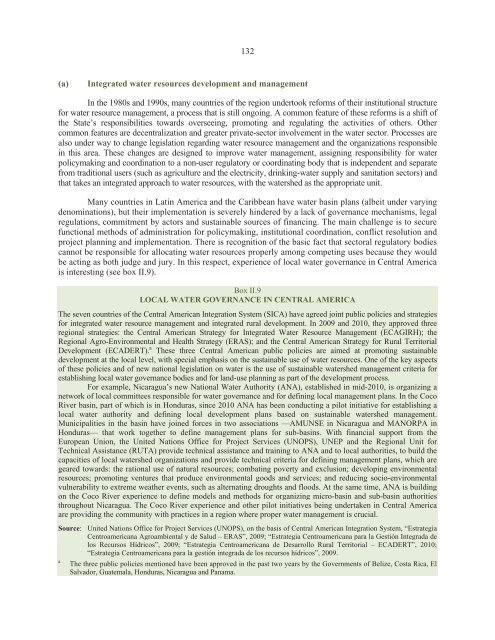sustainable development 20 years on from the ... - José Eli da Veiga
sustainable development 20 years on from the ... - José Eli da Veiga
sustainable development 20 years on from the ... - José Eli da Veiga
You also want an ePaper? Increase the reach of your titles
YUMPU automatically turns print PDFs into web optimized ePapers that Google loves.
132<br />
(a)<br />
Integrated water resources <str<strong>on</strong>g>development</str<strong>on</strong>g> and management<br />
In <strong>the</strong> 1980s and 1990s, many countries of <strong>the</strong> regi<strong>on</strong> undertook reforms of <strong>the</strong>ir instituti<strong>on</strong>al structure<br />
for water resource management, a process that is still <strong>on</strong>going. A comm<strong>on</strong> feature of <strong>the</strong>se reforms is a shift of<br />
<strong>the</strong> State’s resp<strong>on</strong>sibilities towards overseeing, promoting and regulating <strong>the</strong> activities of o<strong>the</strong>rs. O<strong>the</strong>r<br />
comm<strong>on</strong> features are decentralizati<strong>on</strong> and greater private-sector involvement in <strong>the</strong> water sector. Processes are<br />
also under way to change legislati<strong>on</strong> regarding water resource management and <strong>the</strong> organizati<strong>on</strong>s resp<strong>on</strong>sible<br />
in this area. These changes are designed to improve water management, assigning resp<strong>on</strong>sibility for water<br />
policymaking and coordinati<strong>on</strong> to a n<strong>on</strong>-user regulatory or coordinating body that is independent and separate<br />
<strong>from</strong> traditi<strong>on</strong>al users (such as agriculture and <strong>the</strong> electricity, drinking-water supply and sanitati<strong>on</strong> sectors) and<br />
that takes an integrated approach to water resources, with <strong>the</strong> watershed as <strong>the</strong> appropriate unit.<br />
Many countries in Latin America and <strong>the</strong> Caribbean have water basin plans (albeit under varying<br />
denominati<strong>on</strong>s), but <strong>the</strong>ir implementati<strong>on</strong> is severely hindered by a lack of governance mechanisms, legal<br />
regulati<strong>on</strong>s, commitment by actors and <str<strong>on</strong>g>sustainable</str<strong>on</strong>g> sources of financing. The main challenge is to secure<br />
functi<strong>on</strong>al methods of administrati<strong>on</strong> for policymaking, instituti<strong>on</strong>al coordinati<strong>on</strong>, c<strong>on</strong>flict resoluti<strong>on</strong> and<br />
project planning and implementati<strong>on</strong>. There is recogniti<strong>on</strong> of <strong>the</strong> basic fact that sectoral regulatory bodies<br />
cannot be resp<strong>on</strong>sible for allocating water resources properly am<strong>on</strong>g competing uses because <strong>the</strong>y would<br />
be acting as both judge and jury. In this respect, experience of local water governance in Central America<br />
is interesting (see box II.9).<br />
Box II.9<br />
LOCAL WATER GOVERNANCE IN CENTRAL AMERICA<br />
The seven countries of <strong>the</strong> Central American Integrati<strong>on</strong> System (SICA) have agreed joint public policies and strategies<br />
for integrated water resource management and integrated rural <str<strong>on</strong>g>development</str<strong>on</strong>g>. In <str<strong>on</strong>g>20</str<strong>on</strong>g>09 and <str<strong>on</strong>g>20</str<strong>on</strong>g>10, <strong>the</strong>y approved three<br />
regi<strong>on</strong>al strategies: <strong>the</strong> Central American Strategy for Integrated Water Resource Management (ECAGIRH); <strong>the</strong><br />
Regi<strong>on</strong>al Agro-Envir<strong>on</strong>mental and Health Strategy (ERAS); and <strong>the</strong> Central American Strategy for Rural Territorial<br />
Development (ECADERT). a These three Central American public policies are aimed at promoting <str<strong>on</strong>g>sustainable</str<strong>on</strong>g><br />
<str<strong>on</strong>g>development</str<strong>on</strong>g> at <strong>the</strong> local level, with special emphasis <strong>on</strong> <strong>the</strong> <str<strong>on</strong>g>sustainable</str<strong>on</strong>g> use of water resources. One of <strong>the</strong> key aspects<br />
of <strong>the</strong>se policies and of new nati<strong>on</strong>al legislati<strong>on</strong> <strong>on</strong> water is <strong>the</strong> use of <str<strong>on</strong>g>sustainable</str<strong>on</strong>g> watershed management criteria for<br />
establishing local water governance bodies and for land-use planning as part of <strong>the</strong> <str<strong>on</strong>g>development</str<strong>on</strong>g> process.<br />
For example, Nicaragua’s new Nati<strong>on</strong>al Water Authority (ANA), established in mid-<str<strong>on</strong>g>20</str<strong>on</strong>g>10, is organizing a<br />
network of local committees resp<strong>on</strong>sible for water governance and for defining local management plans. In <strong>the</strong> Coco<br />
River basin, part of which is in H<strong>on</strong>duras, since <str<strong>on</strong>g>20</str<strong>on</strong>g>10 ANA has been c<strong>on</strong>ducting a pilot initiative for establishing a<br />
local water authority and defining local <str<strong>on</strong>g>development</str<strong>on</strong>g> plans based <strong>on</strong> <str<strong>on</strong>g>sustainable</str<strong>on</strong>g> watershed management.<br />
Municipalities in <strong>the</strong> basin have joined forces in two associati<strong>on</strong>s —AMUNSE in Nicaragua and MANORPA in<br />
H<strong>on</strong>duras— that work toge<strong>the</strong>r to define management plans for sub-basins. With financial support <strong>from</strong> <strong>the</strong><br />
European Uni<strong>on</strong>, <strong>the</strong> United Nati<strong>on</strong>s Office for Project Services (UNOPS), UNEP and <strong>the</strong> Regi<strong>on</strong>al Unit for<br />
Technical Assistance (RUTA) provide technical assistance and training to ANA and to local authorities, to build <strong>the</strong><br />
capacities of local watershed organizati<strong>on</strong>s and provide technical criteria for defining management plans, which are<br />
geared towards: <strong>the</strong> rati<strong>on</strong>al use of natural resources; combating poverty and exclusi<strong>on</strong>; developing envir<strong>on</strong>mental<br />
resources; promoting ventures that produce envir<strong>on</strong>mental goods and services; and reducing socio-envir<strong>on</strong>mental<br />
vulnerability to extreme wea<strong>the</strong>r events, such as alternating droughts and floods. At <strong>the</strong> same time, ANA is building<br />
<strong>on</strong> <strong>the</strong> Coco River experience to define models and methods for organizing micro-basin and sub-basin authorities<br />
throughout Nicaragua. The Coco River experience and o<strong>the</strong>r pilot initiatives being undertaken in Central America<br />
are providing <strong>the</strong> community with practices in a regi<strong>on</strong> where proper water management is crucial.<br />
Source: United Nati<strong>on</strong>s Office for Project Services (UNOPS), <strong>on</strong> <strong>the</strong> basis of Central American Integrati<strong>on</strong> System, “Estrategia<br />
Centroamericana Agroambiental y de Salud – ERAS”, <str<strong>on</strong>g>20</str<strong>on</strong>g>09; “Estrategia Centroamericana para la Gestión Integra<strong>da</strong> de<br />
los Recursos Hídricos”, <str<strong>on</strong>g>20</str<strong>on</strong>g>09; “Estrategia Centroamericana de Desarrollo Rural Territorial – ECADERT”, <str<strong>on</strong>g>20</str<strong>on</strong>g>10;<br />
“Estrategia Centroamericana para la gestión integra<strong>da</strong> de los recursos hídricos”, <str<strong>on</strong>g>20</str<strong>on</strong>g>09.<br />
a<br />
The three public policies menti<strong>on</strong>ed have been approved in <strong>the</strong> past two <str<strong>on</strong>g>years</str<strong>on</strong>g> by <strong>the</strong> Governments of Belize, Costa Rica, El<br />
Salvador, Guatemala, H<strong>on</strong>duras, Nicaragua and Panama.













